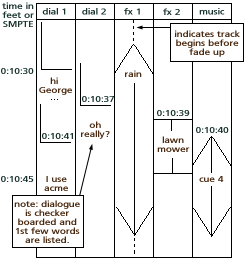| Track assignment |
| Planning |
| On analog multitrack recorders the outer tracks recorded closest to the edges of the tape are most prone to dropout. This is usually more of a problem at high frequencies so it's a good idea to reserve these two tracks for low frequency sounds or any time code if it is used. | If there are more inputs than recorder tracks, sounds can be grouped into mono or stereo mixes to economize on tracks. |
| Track sheets |
| An extremely useful organizational tool for remaining sane during a complex multitrack (or any recording really) session is making and maintaining a track sheet. Although some mixers using a DAW to mix from may not require a mix sheet, the sound designer should always have one. |
| This is simply a sheet of paper with an entry for each recorder track and enough space to write what sound, or instrument is on what track. As changes are made the track sheet is updated immediately and confusion is minimized. More than one instrument may be recorded on different parts of one track so it's useful to keep a log of where these changes begin and end by noting tape counter positions. |  |
| Any other details which might be useful at the mixing stage such as potential problems, processing notes, or other mix ideas can be jotted down as well. | This is very useful as there may be a considerable time lag between recording and mixing and human memory is notoriously volatile. |